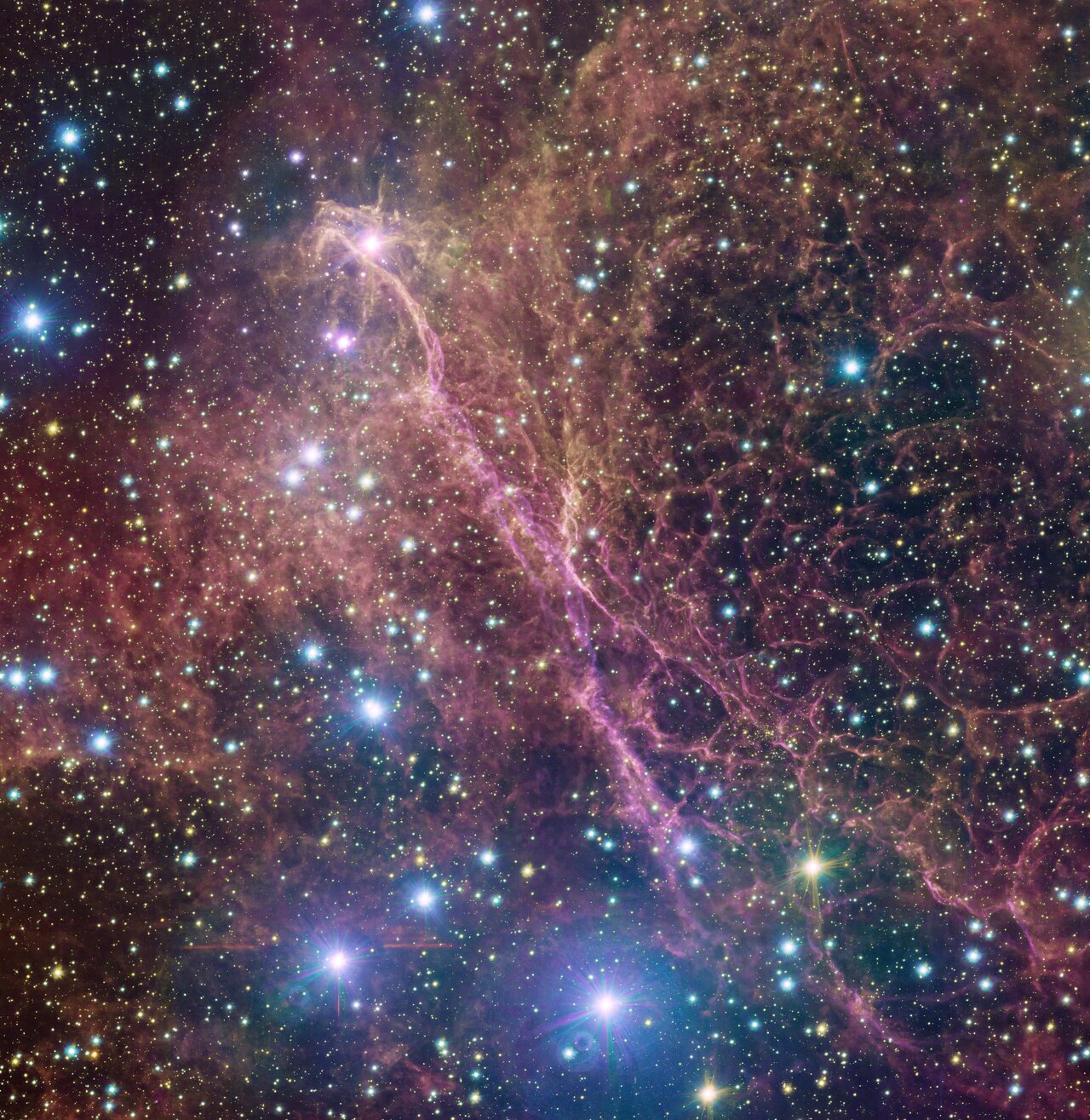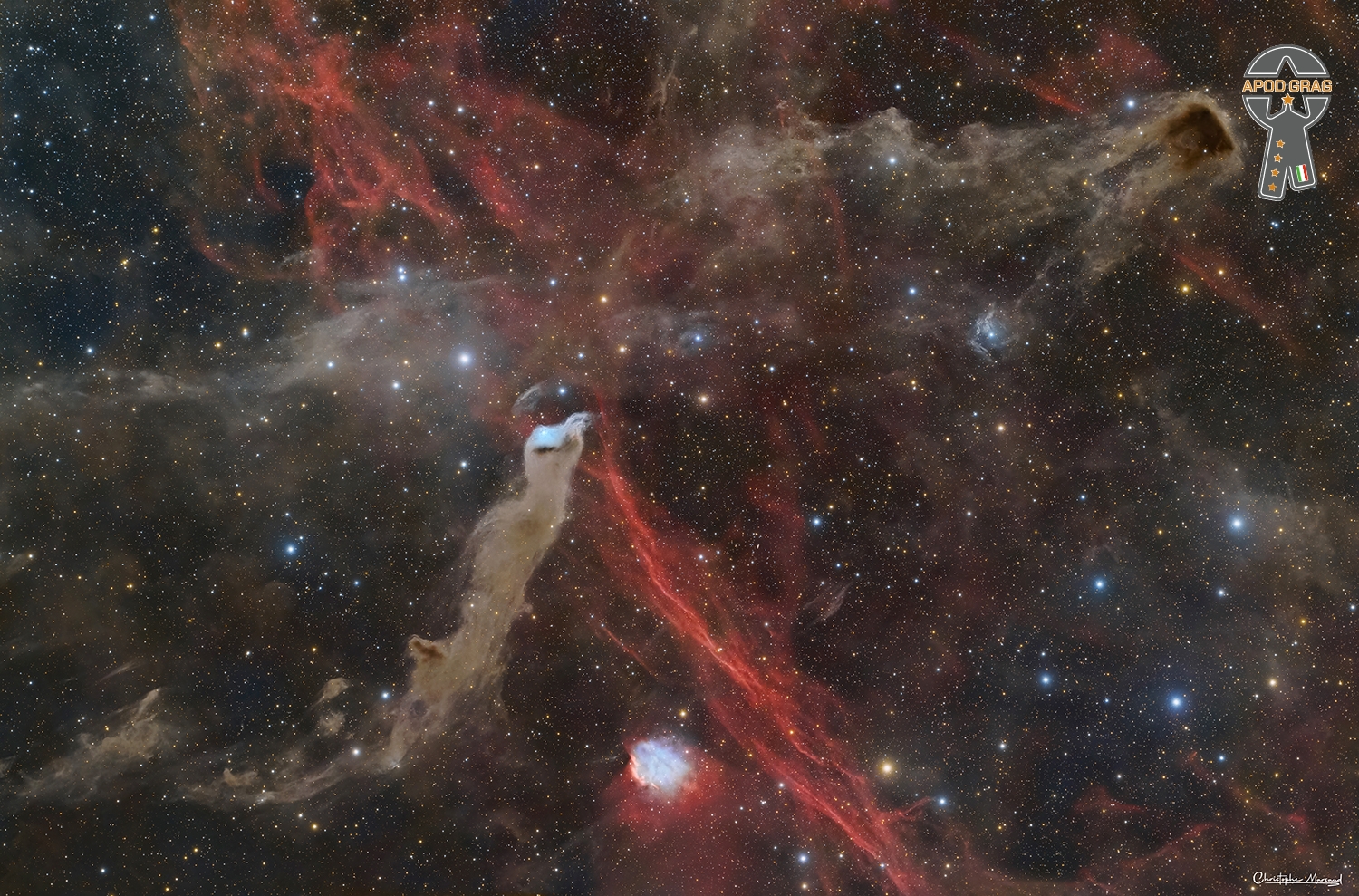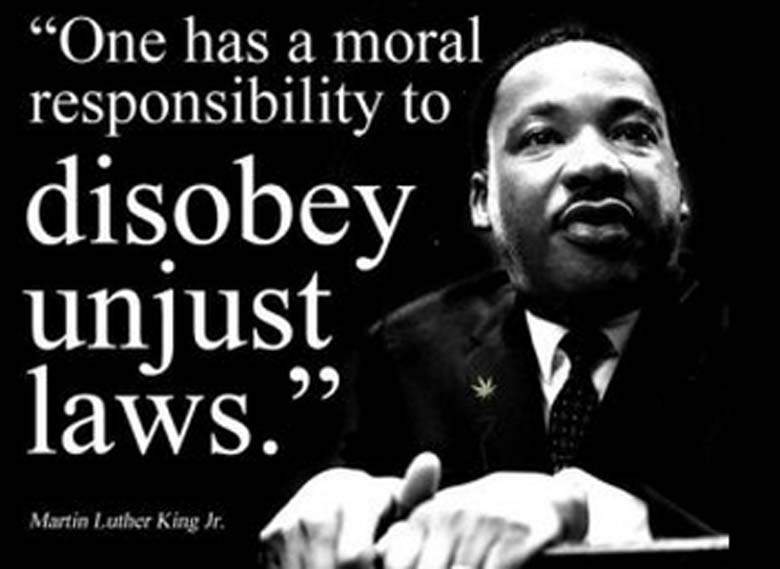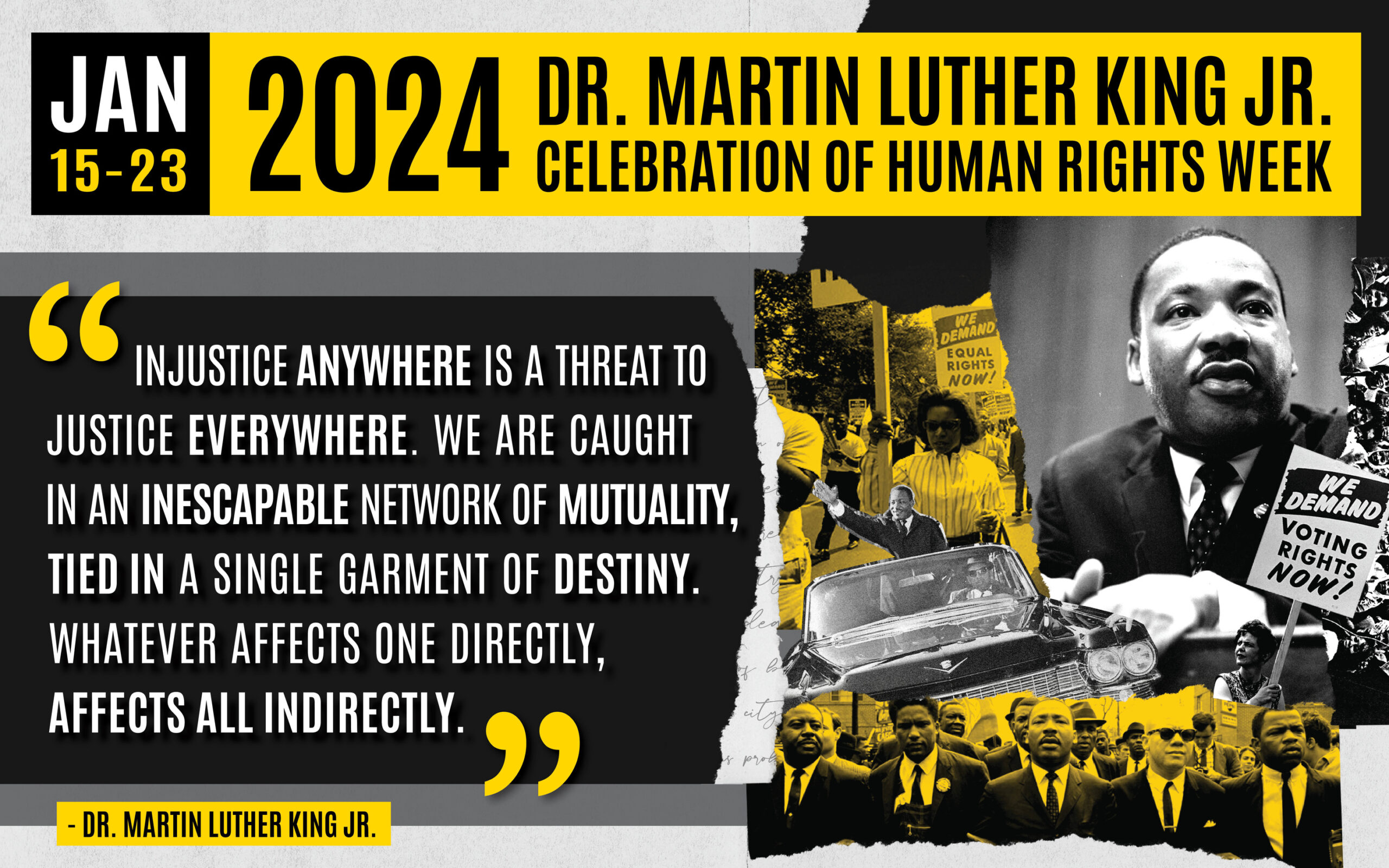Blog
The Vela constellation is visible with the naked eye in the southern sky, but you might miss a lot of details hidden there, like those shown in this Picture of the Week. This is a small patch of the Vela supernova remnant, the intricate leftovers of the explosion of a massive star 11 000 years ago. This image is part of a huge and detailed mosaic captured with the VLT Survey Telescope (VST), hosted at ESO’s Paranal Observatory in the Chilean desert. Pink and orange filamentary clouds swarm around in this picture, resembling the ghostly shadow of a cosmic bird with wide orange wings, a long pink body, and a bright pinkish star as an eye. A myriad of stars are sprinkled all over the image. When massive stars reach the end of their life they explode as supernovae, expelling their outer layers. These explosions send out shock waves that move through the surrounding gas, compressing and reshaping it. This is what creates the intricate structure of filaments seen here, which shine brightly because of the energy released during the explosion.

Don Van Vliet born Don Glen Vliet; January 15, 1941 – December 17, 2010) was an American singer, songwriter, multi-instrumentalist, and visual artist best known by the stage name Captain Beefheart. Conducting a rotating ensemble known as the Magic Band, he recorded 13 studio albums between 1967 and 1982. His music blended elements of blues, free jazz, rock, and avant-gardecomposition with idiosyncratic rhythms, absurdist wordplay, a loud, gravelly voice, and his claimed wide vocal range. Known for his enigmatic persona, Beefheart frequently constructed myths about his life and was known to exercise an almost dictatorial control over his supporting musicians. Although he achieved little commercial success, he sustained a cult following as an influence on an array of experimental rock and punk-era artists.
A prodigy sculptor in his childhood, Van Vliet developed an eclectic musical taste during his teen years in Lancaster, California, and formed “a mutually useful but volatile” friendship with musician Frank Zappa, with whom he sporadically competed and collaborated. He began performing with his Captain Beefheart persona in 1964 and joined the original Magic Band line-up, initiated by Alexis Snouffer, the same year. The group released their debut album Safe as Milk in 1967 on Buddah Records. After being dropped by two consecutive record labels they signed to Zappa’s Straight Records, where they released 1969’s Trout Mask Replica; the album would later rank 58th in Rolling Stone magazine’s 2003 list of the 500 greatest albums of all time. In 1974, frustrated by a lack of commercial success, he pursued a more conventional rock sound, but the ensuing albums were critically panned; this move, combined with not having been paid for a European tour, and years of enduring Beefheart’s abusive behavior, led the entire band to quit.
Beefheart eventually formed a new Magic Band with a group of younger musicians and regained critical approval through three final albums: Shiny Beast (1978), Doc at the Radar Station (1980) and Ice Cream for Crow (1982). Van Vliet made few public appearances after his retirement from music in 1982. He pursued a career in art, an interest that originated in his childhood talent for sculpture, and a venture which proved to be his most financially secure. His abstract expressionist paintings and drawings command high prices, and have been exhibited in art galleries and museums across the world. Van Vliet died in 2010, having had multiple sclerosis for many years.
more...Ida Lewis “Queen Ida” Guillory (born January 15, 1929) is a Louisiana Creole accordionist. She was the first female accordion player to lead a zydeco band. Queen Ida’s music is an eclectic mix of R&B, Caribbean, and Cajun, though the presence of her accordion always keeps it traditional. Born Ida Lee Lewis to a musical family of rice farmers in Lake Charles, Louisiana, United States, her family were Louisiana Creole people and her first language is French. Her family moved to Beaumont, Texas, when she was ten and eight years later moved to San Francisco, California.
more...Earl Zebedee Hooker (January 15, 1930 – April 21, 1970) was a Chicago blues guitarist known for his slide guitar playing. Considered a “musician’s musician”, he performed with blues artists such as Sonny Boy Williamson II, Junior Wells, and John Lee Hooker and fronted his own bands. An early player of the electric guitar, Hooker was influenced by the modern urban styles of T-Bone Walker and Robert Nighthawk. He recorded several singles and albums as a bandleader and with other well-known artists. His “Blue Guitar”, a slide guitar instrumental single, was popular in the Chicago area and was later overdubbed with vocals by Muddy Waters as “You Shook Me“.
In the late 1960s, Hooker began performing on the college and concert circuit and had several recording contracts. Just as his career was on an upswing, he died in 1970, at age 40, after a lifelong struggle with tuberculosis. His guitar playing has been acknowledged by many of his peers, including B.B. King, who commented, “to me he is the best of modern guitarists. Period. With the slide he was the best. It was nobody else like him, he was just one of a kind”.
Hooker was born in rural Quitman County, Mississippi, outside of Clarksdale. In 1930, his parents moved the family to Chicago, during the Great Migration of blacks out of the rural South in the early 20th century. Hooker died on April 21, 1970, at age 40, of complications due to tuberculosis. He is interred in Restvale Cemetery, in the Chicago suburb of Alsip.
more...
Eugene Bertram Krupa (January 15, 1909 – October 16, 1973 Chicago) was an American jazz drummer, bandleader and composer. Krupa is widely regarded as one of the most influential drummers in the history of popular music. His drum solo on Benny Goodman‘s 1937 recording of “Sing, Sing, Sing” elevated the role of the drummer from an accompanist to an important solo voice in the band.
In collaboration with the Slingerland drum and Zildjian cymbal manufacturers, he was a major force in defining the standard band drummer’s kit. Krupa is considered “the founding father of the modern drumset” by Modern Drummer magazine.
Upon his death, The New York Times labeled Krupa a “revolutionary” known for “frenzied, flashy” drumming, with his work having generated a significant musical legacy that started “in jazz and has continued on through the rock era.
more...The sky over Iceland in 2019. The aurora was caused by a hole in the Sun’s corona that expelled charged particles into a solar windthat followed a changing interplanetary magnetic fieldto Earth’s magnetosphere. As some of those particles then struck Earth’s atmosphere, they excited atomswhich subsequently emitted light: aurora. This iconic display was so enthralling that the photographer’s mother ran out to see it and was captured in the foreground. Our active Sun continues to show an unusually high number of prominences, filaments, sunspots, and large active regions as solar maximumapproaches in 2025. 
Steve Jordan (born January 14, 1957 NY, NY) is an American musical director, producer, songwriter, and musician. Currently, he is the drummer for the Rolling Stones. During the 1970s and 1980s, he was a member of the bands for the television shows Saturday Night Live and Late Night with David Letterman.
more...Kenneth Vincent John Wheeler, OC (14 January 1930 – 18 September 2014) was a Canadian composer and trumpet and flugelhorn player, based in the U.K. from the 1950s onwards.
Most of his performances were rooted in jazz, but he was also active in free improvisation and occasionally contributed to rock music recordings. Wheeler wrote over one hundred compositions and was a skilled arranger for small groups and large ensembles.
Wheeler was the patron of the Royal Academy Junior Jazz course.
Wheeler was born in Toronto, Ontario, on 14 January 1930. Growing up in Toronto, he began playing the cornet at age 12 and became interested in jazz in his mid-teens. Wheeler spent a year studying composition at The Royal Conservatory of Music in 1950. In 1952 he moved to Britain. He found his way into the London jazz scene of the time, playing in groups led by Tommy Whittle, Tubby Hayes, and Ronnie Scott.
more...Allen Richard Toussaint January 14, 1938 – November 10, 2015) was an American musician, songwriter, arranger, and record producer. He was an influential figure in New Orleans rhythm and bluesfrom the 1950s to the end of the century, described as “one of popular music’s great backroom figures.”Many musicians recorded Toussaint’s compositions. He was a producer for hundreds of recordings: the best known are “Right Place, Wrong Time“, by longtime friend Dr. John, and “Lady Marmalade” by Labelle. After a lucky break at age 17, in which he stood in for Huey “Piano” Smith at a performance with Earl King‘s band in Prichard, Alabama, Toussaint was introduced to a group of local musicians led by Dave Bartholomew, who performed regularly at the Dew Drop Inn, a nightclub on Lasalle Street in Uptown New Orleans. His first recording was in 1957 as a stand-in for Fats Domino on Domino’s record “I Want You to Know“, on which Toussaint played piano and Domino overdubbed his vocals. His first success as a producer came in 1957 with Lee Allen’s “Walking with Mr. Lee”. He began performing regularly in Bartholomew’s band, and he recorded with Fats Domino, Smiley Lewis, Lee Allen and other leading New Orleans performers.
more...Grady Tate (January 14, 1932 – October 8, 2017) was an American jazz and soul-jazz drummer and baritone vocalist. In addition to his work as sideman, Tate released many albums as leader and lent his voice to songs in the animated Schoolhouse Rock! series. He has 2 Grammy nominations.
Tate was born in Hayti, Durham, North Carolina, United States. In 1963 he moved to New York City, where he became the drummer in Quincy Jones‘s band.
Grady Tate’s drumming helped to define a particular hard bop, soul jazz and organ trio sound during the mid-1960s and beyond. His slick, layered and intense sound is instantly recognizable for its understated style in which he integrates his trademark subtle nuances with sharp, crisp “on top of the beat” timing (in comparison to playing slightly before, or slightly after the beat). The Grady Tate sound can be heard prominently on many of the classic Jimmy Smith and Wes Montgomery albums recorded on the Verve labelin the 1960s.
more...Saturday 1-13-24 7:00 p.m. Sing Unto God: Debbie Friedman Kumsitz\Music with Jayson Rodovsky, Jeff Bailey, Pete Whitman and mick laBriola
Suggested donation of $18 at the door
In Person at Temple Israel and Livestreamed
Join the cantors from around the Twin Cities for Havdalah, hot chocolate, and a sing-along feature Debbie Friedman’s iconic melodies.
This event is sponsored by the Minnesota Cantors Association in partnership with Adath Jeshuran, Bet Shalom, Beth El, Mount Zion, Temple Israel, and Temple of Aaron.
more...DeHt 5 is an emission nebula in the constellation Cepheus. It is estimated to be 1,300-1,600 light years from Earth. Originally catalogued as a planetary nebula, studies have concluded that it is simply a dense part of the interstellar medium (ISM) that is ionised by a hot white dwarf star. The faint red filaments at the top right hand corner of the image are the supernova remnant called SNR 110.3+11.3.

More Posts
- Doc Cheatham Day
- World Music with Ousmane Toure
- Daily Roots with Sizzla
- Music for Surviving the Pandemic and Realizing Racial Justice
- The Cosmos with NGC 2359
- Chick Corea Day
- Marcus Belgrave Day
- Juan del Encina Day
- Flamenco Fridays with Sabicas
- Daily Roots with Anthony B
- Music for Surviving the Pandemic and Realizing Racial Justice
- The Cosmos with NGC 1300
- Jamaaladeen Tacuma Day
- Bernard Purdie
- Shelly Manne Day
- Hazel Scott Day
- Clarence Pinetop Smith Day
- World Music with Don Pío Alvarado
- Daily Roots with Slyford Walker
- Music for Surviving the Pandemic and Realizing Racial Justice

